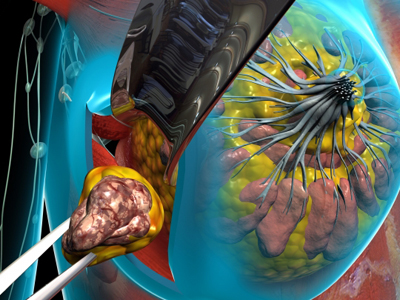Partial Mastectomy – Lumpectomy
Description lumpectomy
Lumpectomy – removing a portion of the breast.
Lumpectomy may be combined with the sampling procedure lymph nodes in the chest (axillary dissection or biopsy sentinel node).

Reasons for a lumpectomy
Lumpectomy is performed to treat Breast Cancer.
Possible complications of lumpectomy
Complications are rare, but no procedure does not guarantee the absence of risk. If you plan a lumpectomy, you need to know about possible complications, which may include:
- The accumulation of blood in the wound;
- Collect clear liquid in the wound;
- Infection;
- Numbness of the skin of the nipple or armpit;
- Change the size and / or shape of the breast;
- Blood clots;
- Reaction to anesthesia.
Some factors, that may increase the risk of complications:
- Obesity;
- Poor diet;
- Smoking;
- Recent or long-term illness;
- The use of some drugs;
- Features of the tumor, to be deleted.
How is a lumpectomy?
Preparing for Surgery
Your doctor may perform the following procedures, or:
- Physical examination;
- Mammogram – analysis using X-ray radiation, to take a picture of the chest;
- Breast fine needle biopsy;
- Blood and urine tests;
- Wire localization procedure – if the tumor is visible on a mammogram, but it is impossible to find, doctor, It will use a thin wire, to determine the exact location of the tumor;
Perhaps it will be necessary to stop taking certain medications one week before surgery:
- Aspirin or other anti-inflammatory drugs;
- Blood thinners, such as clopidogrel (Plaviks) or warfarin.
Do not eat or drink for 8-12 hours before surgery, without the permission of the doctor.
Anesthesia
The operation is performed under the general anesthesia, during the operation the patient is asleep.
Procedure lumpectomy
The breast is made a small incision. Tumor, along with some of the surrounding tissue is cut. Another incision may be made near the armpit, for, to remove the lymph nodes. The nipple and areola are not removed. Accumulating drainage fluid can be inserted into the drainage tube. The incisions will be sewn.
Immediately after the procedure lumpectomy
Removed tissue will be examined. The results will help determine, whether further surgery.
How long will a lumpectomy?
About 1-3 o'clock.
Lumpectomy – Will it hurt?
Anesthesia prevents pain during the procedure. After removal of tumors may be relatively small pains. Also in the field of operation may be temporary discomfort, including numbness and tingling, or pulling feeling in the underarm area. Patients, who performed lymph node biopsy, usually, feel more discomfort. If necessary, it can be assigned to painkillers.
Care after lumpectomy
Keep the area clean and dry operation;
- Ask the doctor, when it is safe to shower, bathe or expose the surgical site to water;
- The doctor can set one or more tubes to drain blood and fluids during recovery. Clean them, measures the amount of fluid levels, and inform the doctor about any problems;
- If drains have been installed, They will be removed in the doctor's office through 1-2 day;
- Avoid vigorous activity for about four weeks, or as prescribed by your doctor;
- Try not to lift anything heavier, than 3 kg for a week or longer after the operation, if prescribed by your doctor;
- Wear well-fitting supportive bra 24 hours a day during the first week.
If after surgery complications develop in the lymph nodes, you need to take special precautions:
- You can not measure blood pressure, take blood for analysis, as well as to take pictures of hands, where biopsy;
- Wear gloves, to wash dishes, perform cleaning;
- Do not wear anything, tight fitting arm;
- Do not carry heavy packages, bags, suitcases, grocery bags in her hand, where biopsy;
- For the area of the biopsy need to use a moisturizer;
- Use an electric shaver, if you are going to shave your armpits;
- If the lymph nodes in the axilla is removed during the removal of breast cancer, Physical therapy will help prevent lymphedema.
Chest can change the size or shape after removal of the tumor. There may be local skin discoloration from dye, which is used to locate lymph node biopsy. The dye may also discolor urine within a short time after the operation. You need to see a doctor for further examination within 7-14 days after surgery.
The operation is usually accompanied by a corresponding course radiation therapy, and in some cases Chemotherapy.
Contact your doctor after lumpectomy
After returning home, you need to see a doctor, If the following symptoms:
- Signs of infection, including fever and chills;
- Redness, edema, strong pain, bleeding or discharge from the incision;
- If installed drainage pipes, Tell your doctor about any problems with them;
- Oozing or discharge from the nipple to the breast;
- Swelling, redness or swelling in either breast;
- If the lymph nodes were removed: redness, fever, swelling, stiffness and hardness of the limbs;
- Nausea and / or vomiting, which do not disappear after taking the prescribed medicines and persist for more than two days after discharge from the hospital;
- Pain, which does not pass after taking pain medication appointed;
- Cough, breathlessness, chest pain;
- Depression;
- Other painful symptoms.
